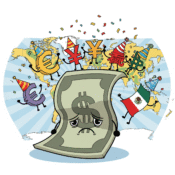The Boomerang Effect of Trump’s Tariffs on Mexico & Canada
The re-imposition or expansion of tariffs on Mexico and Canada under the Trump administration has sparked significant concern among economists, businesses, and policymakers. While tariffs are often framed as tools to protect domestic industries and address trade imbalances, their broader impacts can be far-reaching and complex, particularly for closely integrated economies like those of the United States, Mexico, and Canada.
Economic Disruption in North America
The United States-Mexico-Canada Agreement (USMCA), which replaced NAFTA, was designed to foster free trade and economic cooperation among the three nations. However, the introduction of tariffs threatens to undermine this framework. Mexico and Canada are two of the U.S.'s largest trading partners, and tariffs on goods like steel, aluminum, automobiles, and agricultural products could disrupt supply chains that have been decades in the making. Industries reliant on cross-border trade, such as automotive manufacturing, could face higher production costs, reduced competitiveness, and potential job losses.
Inflation and Consumer Costs
Tariffs often lead to higher prices for imported goods, which can trickle down to consumers. For example, tariffs on Mexican agricultural products like avocados or Canadian lumber could increase costs for U.S. consumers. Similarly, tariffs on raw materials like steel and aluminum could raise prices for manufactured goods, from appliances to construction materials. This inflationary pressure could strain household budgets and dampen consumer spending, a key driver of economic growth.
Retaliatory Measures
Historically, both Mexico and Canada have responded to U.S. tariffs with targeted retaliatory measures. For instance, Canada previously imposed tariffs on U.S. products like whiskey, dairy, and steel in response to U.S. actions. Such retaliatory tariffs can hurt U.S. exporters, particularly farmers and small businesses, who rely on these markets. This tit-for-tat escalation risks creating a trade war that could harm all three economies.
Impact on North American Competitiveness
The North American region competes globally as an integrated bloc. Tariffs that increase costs and disrupt trade could weaken the region's competitive edge against other economic powerhouses like China and the European Union. For example, higher costs for automotive parts due to tariffs could make North American vehicles less competitive in global markets, potentially leading to lost market share.
Political and Diplomatic Strains
Beyond economics, tariffs could strain diplomatic relations between the U.S. and its neighbors. Mexico and Canada are not only trade partners but also key allies in addressing shared challenges like migration, security, and climate change. Trade disputes fueled by tariffs could erode trust and cooperation in these areas, with long-term geopolitical consequences.
Conclusion
While tariffs may offer short-term protection for specific U.S. industries, their broader impacts on the North American economy could be detrimental. Higher costs, disrupted supply chains, retaliatory measures, and strained diplomatic relations all pose significant risks. As the U.S., Mexico, and Canada navigate this complex trade landscape, a focus on collaboration and fair trade practices may prove more beneficial than punitive tariffs in ensuring long-term prosperity for the region.



